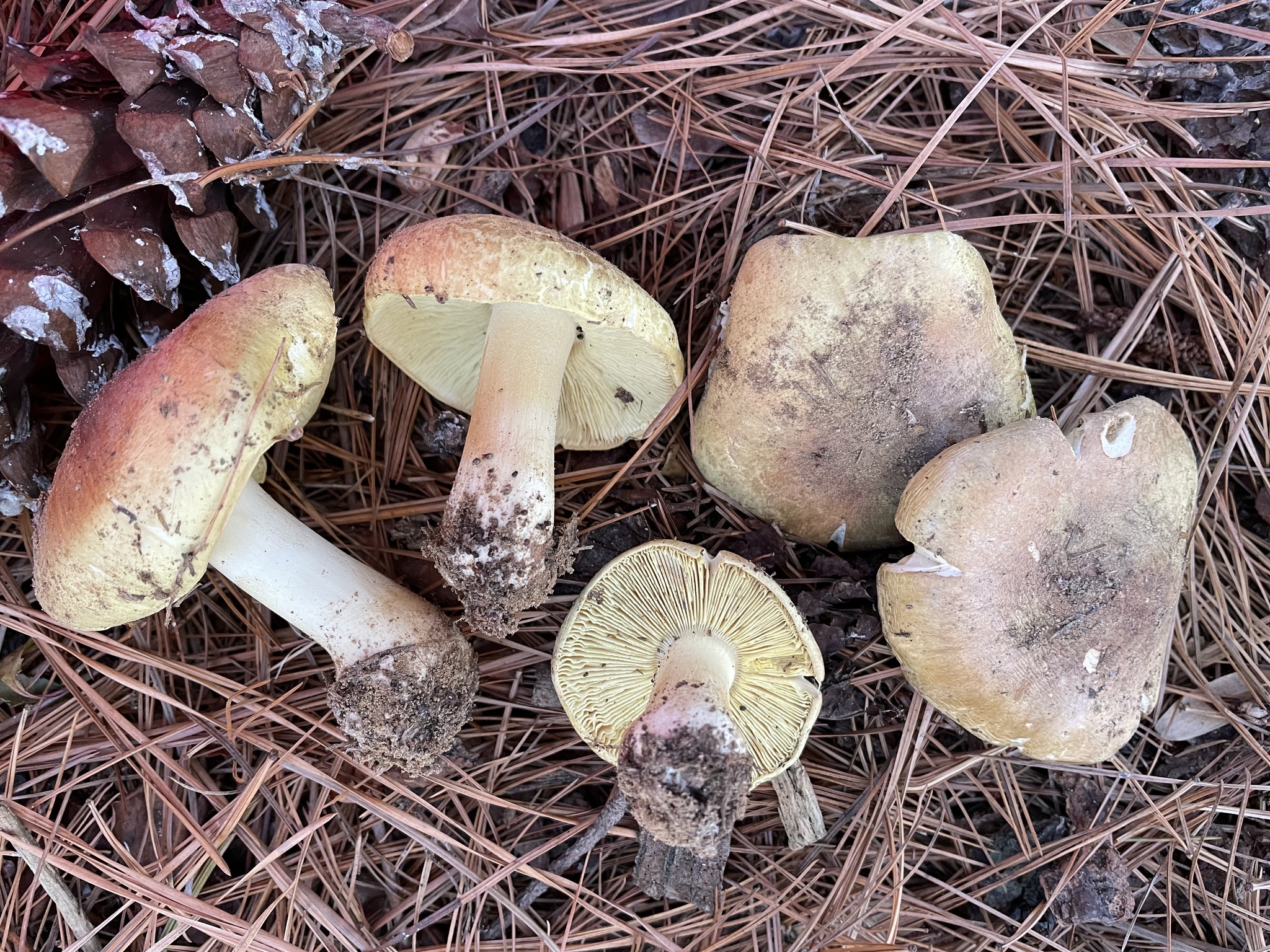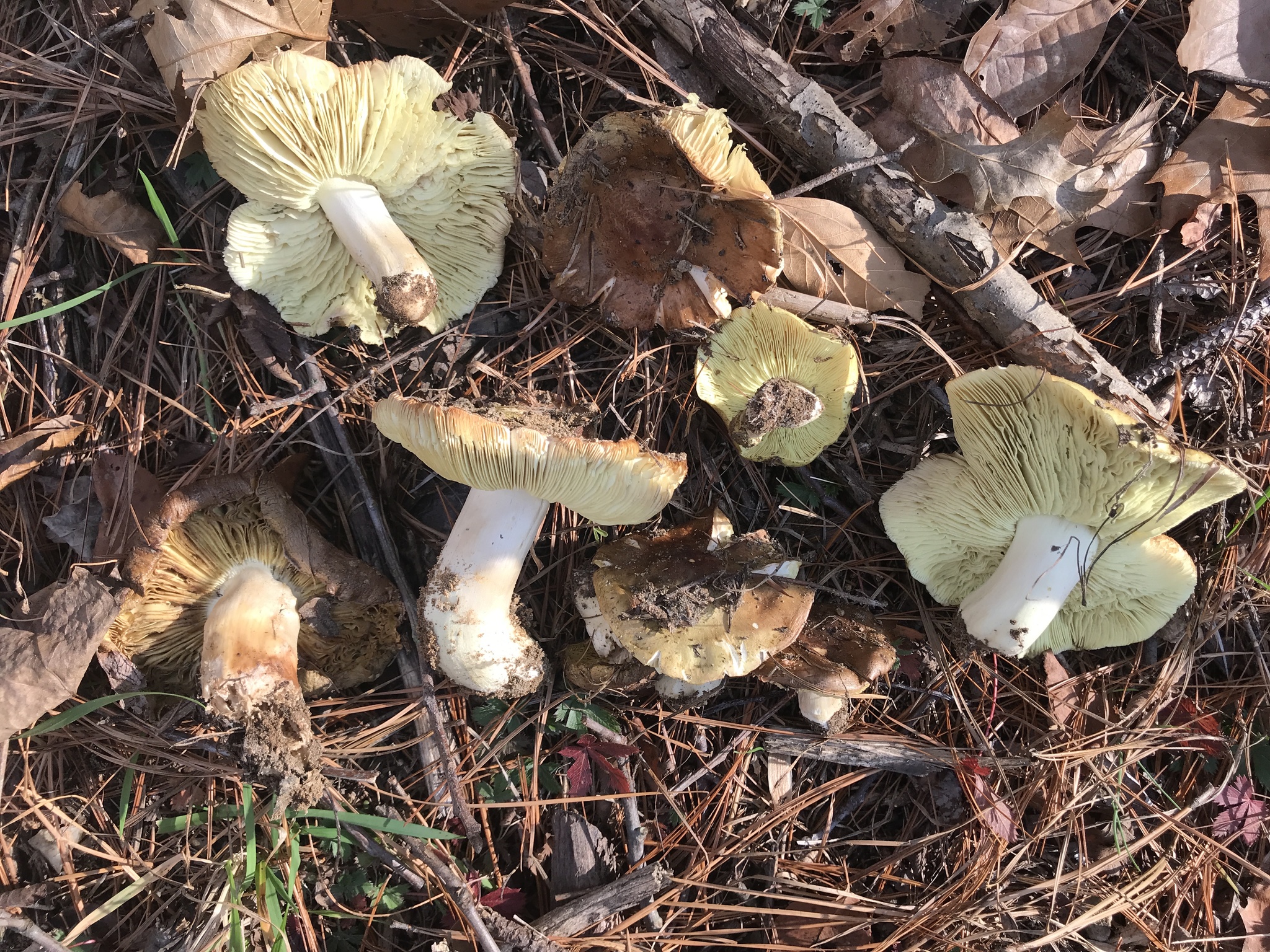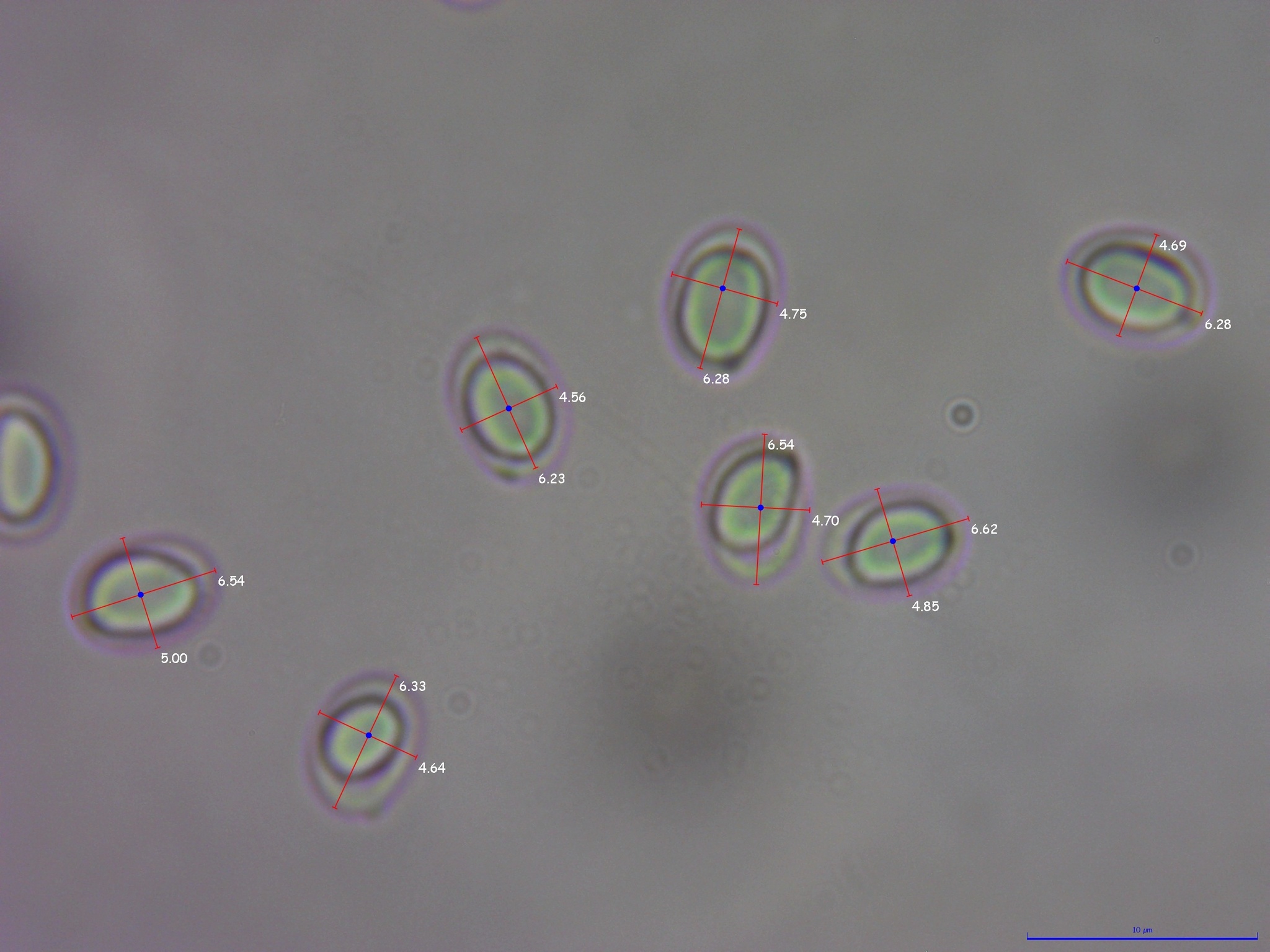Map Snapshot








28 Records
Seasonality Snapshot
Source: Wikipedia
| Tricholoma equestre | |
|---|---|

| |
| Scientific classification | |
| Domain: | Eukaryota |
| Kingdom: | Fungi |
| Division: | Basidiomycota |
| Class: | Agaricomycetes |
| Order: | Agaricales |
| Family: | Tricholomataceae |
| Genus: | Tricholoma |
| Species: | T. equestre
|
| Binomial name | |
| Tricholoma equestre | |
| Tricholoma equestre | |
|---|---|
| Gills on hymenium | |
| Cap is flat | |
| Hymenium is adnexed | |
| Stipe is bare | |
| Spore print is white | |
| Ecology is mycorrhizal | |
| Edibility is not recommended or poisonous | |
Tricholoma equestre or Tricholoma flavovirens, commonly known as the man on horseback or yellow knight is a widely eaten but arguably toxic fungus of the genus Tricholoma that forms ectomycorrhiza with pine trees.
Known as Grünling in German, gąska zielonka in Polish, míscaro in Portuguese and canari in French, it has been treasured as an edible mushroom worldwide and is especially abundant in France and Central Portugal. Although it is regarded as quite tasty, cases of poisoning from eating T. equestre have been reported. Research has revealed it to have poisonous properties, but these claims are disputed.[1]
Taxonomy and naming
[edit]Tricholoma equestre was known to Linnaeus who officially described it in Volume Two of his Species Plantarum in 1753, giving it the name Agaricus equestris,[2] predating a description of Agaricus flavovirens by Persoon in 1793. Thus this specific name meaning "of or pertaining to horses" in Latin takes precedence over Tricholoma flavovirens, the other scientific name by which this mushroom has been known. It was placed in the genus Tricholoma by German Paul Kummer in his 1871 work Der Führer in die Pilzkunde. The generic name derives from the Greek trichos/τριχος 'hair' and loma/λωμα 'hem', 'fringe' or 'border'.[3]
Common names include the man-on-horseback, yellow knight, and saddle-shaped tricholoma.
Description
[edit]The cap ranges from 5–15 cm (2–6 in) in width and is usually yellow with brownish areas, particularly at the centre.[4] The stem is 4–10 cm long and 1–4 wide, is yellow, and brownish at the base.[4] The gills are also yellow colour and the spores are white.[4] The skin layer covering the cap is sticky and can be peeled off.
Toxicity
[edit]This species was for a long time highly regarded as one of the tastier edible species (and in some guides still is),[5] and sold in European markets; medieval French knights allegedly reserved this species for themselves, leaving the lowly bovine bolete (Suillus bovinus) for the peasants.[6]
Concern was first raised in southwestern France. People who have been poisoned have all had three or more meals containing T. equestre within the last two weeks prior to treatment. One to four days after their last meal containing the fungus, the patients reported weakness of the muscles, sometimes accompanied by pain. This weakness progressed for another three to four days accompanied by a feeling of stiffness and darkening of the urine. Periods of nausea, sweating, reddening of the face were also registered, but there were no fevers.[7]
As yet, there have been no reported cases of poisoning in North America,[8] and there is speculation that the respective mushrooms may in fact be different species that are very similar in appearance. Molecular research shows that multiple species may have been identified as T. flavovirens on the West Coast.[9]
There are reports where patients treated for T. equestre poisoning have died, likely as a result of the poisoning.[10] The poison in this mushroom has remained unknown. The basic mechanism of poisoning is suspected to be rhabdomyolysis, damaging of the cell membrane of skeletal muscle fibres. In this disorder, the oxygen-carrying muscular protein myoglobin is released and appears in urine, resulting in symptoms such as muscle pain and brownish coloration of the urine.[11]
A 2018 research conducted in Poland with the recruitment of ten healthy volunteers, who ate 300 grams per head (about twice the normal dose) of fried T. equestre in a single meal, with no reported consequences or alterations.[12] However, a 2020 systematic review highlights several studies indicating elevated plasma creatine kinase (CK) pro-inflammatory activities, in addition to its effect on other liver function biomarkers, underlining a cause for concern and suggestions "not to harvest and consume this species".[13] From the same 2020 study, they registered the same level of plasma CK using different edible mushrooms. For example the same level obtained by T. equestre was also obtained by Boletus edulis.
Similar species
[edit]It can easily be mistaken for a variety of other members of the genus Tricholoma, such as T. auratum, T. aestuans,[citation needed] T. intermedium, T. sejunctum, and T. sulphureum.[4] Other similar species include Floccularia albolanaripes and F. luteovirens.[4]
See also
[edit]- Pine mushroom
- Mushroom hunting
- List of deadly fungi
- List of North American Tricholoma
- List of Tricholoma species
Footnotes
[edit]- ^ Piotr Rzymski, Piotr Klimaszyk, "Is the Yellow Knight Mushroom Edible or Not? A Systematic Review and Critical Viewpoints on the Toxicity of Tricholoma equestre" https://onlinelibrary.wiley.com/doi/full/10.1111/1541-4337.12374
- ^ Linnaeus, C (1753). Species Plantarum: Tomus II (in Latin). Holmiae. (Laurentii Salvii). p. 1173.
- ^ Nilson, Sven; Olle Persson (1977). Fungi of Northern Europe 2: Gill-Fungi. Penguin. p. 24. ISBN 0-14-063006-6.
- ^ a b c d e Davis, R. Michael; Sommer, Robert; Menge, John A. (2012). Field Guide to Mushrooms of Western North America. Berkeley: University of California Press. pp. 160–161. ISBN 978-0-520-95360-4. OCLC 797915861.
- ^ Phillips, Roger (2010). Mushrooms and Other Fungi of North America. Buffalo, NY: Firefly Books. p. 49. ISBN 978-1-55407-651-2.
- ^ Lamaison, Jean-Louis; Polese, Jean-Marie (2005). The Great Encyclopedia of Mushrooms. Könemann. p. 90. ISBN 3-8331-1239-5.
- ^ Meister, John; Reddy, Kathleen (2002). "Rhabdomyolysis: An Overview". The American Journal of Nursing. 102 (2): 75–79. doi:10.1097/00000446-200202000-00028. ISSN 0002-936X. JSTOR 3522796. PMID 11953525.
- ^ Miller Jr., Orson K.; Miller, Hope H. (2006). North American Mushrooms: A Field Guide to Edible and Inedible Fungi. Guilford, CN: FalconGuide. p. 125. ISBN 978-0-7627-3109-1.
- ^ Trudell, Steve; Ammirati, Joe (2009). Mushrooms of the Pacific Northwest. Timber Press Field Guides. Portland, OR: Timber Press. p. 102. ISBN 978-0-88192-935-5.
- ^ Bedry R, Baudrimont I, Deffieux G, et al. (2001). "Wild-mushroom intoxication as a cause of rhabdomyolysis". N. Engl. J. Med. 345 (11): 798–802. doi:10.1056/NEJMoa010581. PMID 11556299.
- ^ Saviuc, Phillippe; Danel, Vincent (2006). "New syndromes in mushroom poisoning". Toxicological Reviews. 25 (3): 199–209. doi:10.2165/00139709-200625030-00004. PMID 17192123. S2CID 24320633.
- ^ Klimaszyk, Piotr; Rzymski, Piotr (2018). "The Yellow Knight Fights Back: Toxicological, Epidemiological, and Survey Studies Defend Edibility of Tricholoma equestre". Toxins. 10 (11): 468. doi:10.3390/toxins10110468. PMC 6267205. PMID 30428584.
- ^ Nieminen, Petteri; Mustonen, Anne-Mari (2020). "Toxic Potential of Traditionally Consumed Mushroom Species—A Controversial Continuum with Many Unanswered Questions". Toxins. 12 (10): 639. doi:10.3390/toxins12100639. PMC 7599650. PMID 33023182.
External links
[edit]- Food for Thought: Mushrooming Concerns "Science News Online" article on T. flavovirens (T. equestre).
- Tricholoma equestre poisoning "About Health Canada" article on Tricholoma equestre poisoning.
- Recent Poisonings from Edible Mushrooms! A report on a few new kinds of mushroom poisoning.
- Riddarmusseronen kan vara giftig Swedish article on T. flavovirens and its toxicity.
- Matportalen: Matsoppen som ble giftsopp Norwegian article on T. equestre.


